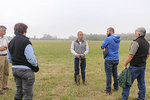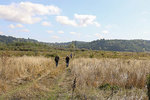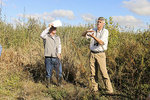




After taking a tour of the Pleasant Valley Mitigation Site last week, the state Department of Ecology has decided it will authorize 25.7 acres of additional wetland impacts for the Port of Chehalis as the process of renewing the port’s regional general permit continues.
The permit, which is used to offset wetland fill on port-owned property, lapsed in September of last year. Twenty-five acres of credit were authorized under the original permit, six of which have already been used. Officials from Ecology said they wouldn’t have a problem authorizing wetland fill for the 19 acres left at the site, but later increased that amount after touring the mitigation site. The port’s application requested 40 acres.
“We have authorized 25.7 acres of additional wetland impacts based on the analysis of the functional equivalence found at the Pleasant Valley Mitigation Site,” Perry Lund, from Ecology, said in an email to the port on Tuesday.
Randy Mueller, CEO of the port, said that amount would now account for the full capacity of the site.
In order to receive a new permit, there are two separate processes that need to take place. The state Department of Ecology must certify the amount of acres through its 401 certification process that deals with water quality. Then, the U.S. Army Corps of Engineers is the one that’s responsible for making the final decision on whether the permit is approved, along with the final acre amount.
The Corps could still decide to authorize a permit with a higher acre amount, but in order for that to be implemented, the port needs Ecology’s approval as well.
“In practice, if the Corps decided to grant us the 40 acres, we wouldn’t have approval from the state Department of Ecology,” Mueller said. “We’d have to get that.”
After a tour of the mitigation site off of Twin Oaks Road near Adna, Lund said that although he realized the value of the mitigation site, he was still against authorizing the 40 credits the port requested.
“I haven’t changed my mind,” he said.
Earlier this year, the request to add more acreage set off red flags with regulatory agencies that said if that was approved, it would be the largest authorization of wetland fill in the state.
The Environmental Protection Agency, Ecology, and the Quinault Indian Nation submitted comments opposing the request.
Port commissioners have stated the quality of wetlands they have created at the mitigation site far exceed those that would be filled with future development.
Wetlands like those on the Bishop Road Industrial Site 2 — which was part of last week’s tour — are categorized as low quality class 4 wetlands, or farm fields.
Ecology had one year to respond to a request for certification, and beat the deadline by a few days, while the Corps does not have a set timeline to make a decision.
After opposition was voiced earlier this year, the port submitted various documents that included an updated alternatives analysis and a cumulative impacts assessment to try to ease those concerns.
Staff from the EPA attended the tour, and submitted further comments afterwards.
Michael Szerlog, with the EPA, visited the site six years ago. He clarified that the ultimate decision lies in the hands of the Corps and Ecology.
“We look at individual regional general permits when there’s one very unique or different,” he said.
On Sept. 29, Szerlog submitted additional comments to the Corps following the tour, which said more in-depth information could help with permitting requests in the future.
With Ecology’s recommendation in hand, the Corps will now consider what acreage they are comfortable with.
After the tour, Muffy Walker, with the Corps, said the agency felt comfortable granting 25 acres.
“When talking about cumulative impacts, we are feeling comfortable with 25 acres, but once you start getting over that then the cumulative impacts become more and more of a concern,” she said.
Pleasant Valley Mitigation Site Tour
The tour of the site on Sept. 26 was organized by staff from Senator Maria Cantwell’s Office who later mediated the discussion between the agencies. Officials from Ecology, the Corps and the EPA attended.
It started at Bishop Road Industrial Site 2, where staff from Ecological Land Services hired by the port, explained the makeup of the wetlands that would be mitigated for when construction occured on the site.
In the spring, the ground is saturated, but it later dries out.
“You don’t even realize you are standing in wetlands,” Port Commissioner Ken Kostick said. “We’re not taking a swamp and filling it in. It’s dry nine months out of the year.”
During the 2007 flood, port property saw minimal impacts, Mueller said, adding the water that did appear was gone within 24 hours.
“We’re on the higher and drier side (of the Interstate),” he said.
Commissioners said there are no projects currently slated for the site. Instead, they said the port wants to be prepared and have an efficient process that would allow development, something they said the RGP helps accomplish. Without the RGP, each site would have to go through an individual permitting process before it was developed which has a two-year timeline.
The Pleasant Valley Mitigation Site near Adna was also toured. The port has a 99-year lease for the site, which used to be a flat field. Native species were planted and the ground was reshaped to allow 12,000 acre feet of water storage with no import or export of material like dirt.
Francis Naglich, with Ecological Land Services, said there is a herd of elk that frequents the area, as well as beavers and muskrats. It also includes fish habitat.